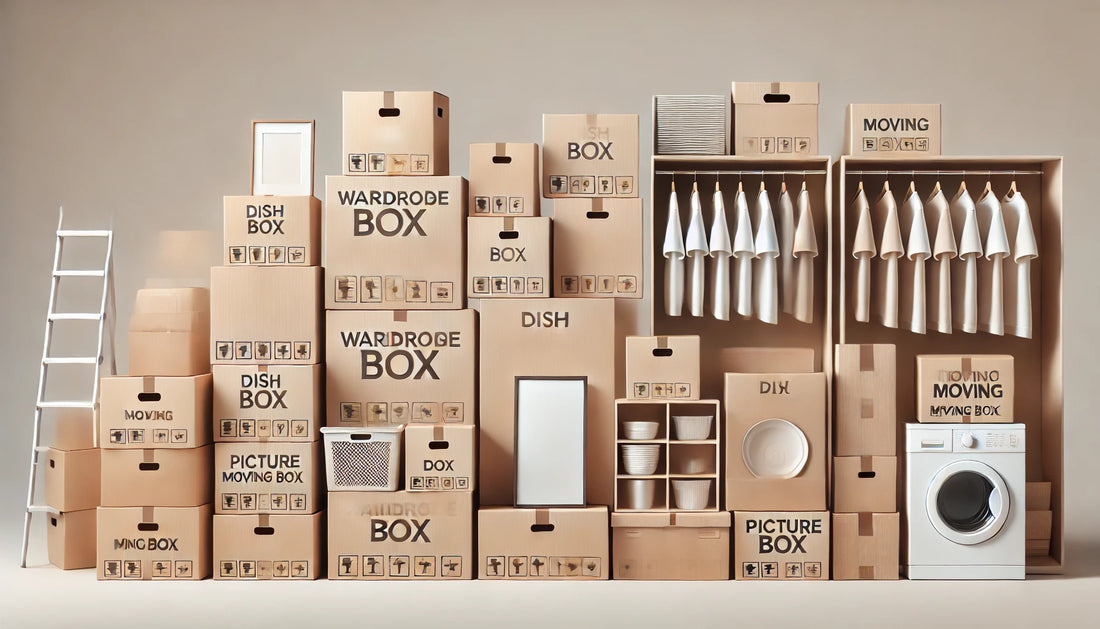
Moving boxes
Share
Moving Boxes: Everything You Need to Know
Introduction
Moving can be an overwhelming task, filled with a long list of to-dos and logistics to manage. One crucial aspect of any move is packing, and at the heart of packing are moving boxes. In this comprehensive guide, we'll explore everything you need to know about moving boxes—from choosing the right type to packing efficiently and sustainably. Whether you're moving across town or across the country, understanding how to use moving boxes effectively can save you time, money, and stress.
Types of Moving Boxes
Standard Cardboard Boxes
Standard cardboard boxes are the most commonly used moving boxes. They come in various sizes, typically small, medium, large, and extra-large. These boxes are versatile and suitable for packing most household items.
- Small Boxes (1.5 cubic feet): Ideal for heavy items like books, canned goods, and tools.
- Medium Boxes (3 cubic feet): Great for kitchen items, small appliances, and toys.
- Large Boxes (4.5 cubic feet): Suitable for lightweight, bulky items like linens, pillows, and lampshades.
- Extra-Large Boxes (6 cubic feet): Best for large, lightweight items such as comforters, blankets, and large pillows.
Specialty Boxes
Specialty boxes are designed for specific items, providing extra protection and convenience.
- Wardrobe Boxes: Tall boxes with a metal bar for hanging clothes. These boxes keep garments wrinkle-free and are available in various sizes.
- Dish Boxes: Double-walled boxes that provide extra protection for fragile items like dishes and glassware. Often used with cell dividers for added security.
- Picture/Mirror Boxes: Adjustable boxes designed to fit around framed artwork, mirrors, and other flat items to prevent damage during transit.
- TV Boxes: Designed to protect flat-screen televisions. These boxes usually come with foam inserts to secure the TV.
Plastic Moving Boxes
Plastic moving boxes are a reusable alternative to cardboard. They are sturdy, weather-resistant, and stackable, making them an excellent option for environmentally conscious movers.
- Pros: Durable, eco-friendly, easy to stack, and no need for tape.
- Cons: More expensive upfront and can be challenging to find in some areas.
How to Choose the Right Moving Boxes
Assess Your Needs
Start by taking an inventory of your belongings. Consider the size, weight, and fragility of each item. This assessment will help you determine the types and quantities of moving boxes you'll need.
Consider the Move's Distance and Conditions
For long-distance moves or moves involving storage, investing in high-quality, durable boxes is essential. Weather conditions can also impact your choice—plastic boxes are ideal for moves during rainy seasons or in humid climates.
Budget
While specialty boxes and plastic bins can be more expensive, they provide better protection for your belongings. Balancing cost with the level of protection needed is crucial for a smooth move.
Where to Buy Moving Boxes
Retail Stores
- Home Improvement Stores: Home Depot and Lowe's offer a wide range of moving boxes and packing supplies.
- Office Supply Stores: Stores like Staples and Office Depot also carry moving boxes, particularly small and medium sizes.
- Big-Box Retailers: Walmart and Target provide a variety of moving boxes, often at competitive prices.
Online Retailers
- Amazon: Offers a vast selection of moving boxes, often with customer reviews to help you choose the best options.
- U-Haul: Provides moving boxes and supplies online, with the added convenience of in-store pickup.
- BoxCycle: A marketplace for buying and selling used moving boxes, promoting sustainability.
Moving Companies
Many moving companies sell boxes and packing supplies. This option can be convenient, especially if you're hiring movers and want to streamline the process.
Free Boxes
- Grocery Stores: Often have sturdy boxes that can be used for moving.
- Liquor Stores: Provide boxes designed to carry heavy bottles, making them ideal for books and other heavy items.
- Online Marketplaces: Websites like Craigslist and Facebook Marketplace frequently have listings for free moving boxes.
Packing Tips and Best Practices
Start Early
Begin packing well in advance of your move date. Start with items you use less frequently, such as seasonal clothing and decorations.
Label Everything
Clearly label each box with its contents and the room it belongs in. This practice will make unpacking much more manageable and help movers place boxes in the correct rooms.
Pack Strategically
- Heavy Items: Use small boxes for heavy items to prevent them from becoming too heavy to lift safely.
- Fragile Items: Wrap fragile items in packing paper or bubble wrap and place them in boxes with dividers when possible.
- Utilize Space: Fill gaps in boxes with packing paper, towels, or clothing to prevent items from shifting during transit.
Don't Overpack
Avoid overloading boxes, especially larger ones. This can lead to box failure and damage to your belongings. A good rule of thumb is to keep boxes under 50 pounds.
Seal Boxes Properly
Use high-quality packing tape to seal boxes. Reinforce the bottom and top seams with additional strips of tape for added security.
Sustainability and Moving Boxes
Reuse and Recycle
Whenever possible, reuse boxes from previous moves or obtain used boxes from friends, family, or online marketplaces. After your move, recycle cardboard boxes or pass them on to someone else who can use them.
Eco-Friendly Alternatives
Consider using biodegradable packing materials like cornstarch packing peanuts and recycled paper. Renting plastic moving boxes is another sustainable option that reduces waste.
Donate Unused Boxes
If you have unused boxes after your move, consider donating them to local charities, schools, or community organizations.
Conclusion
Moving boxes are an essential component of any successful move. By choosing the right types of boxes, sourcing them wisely, and packing strategically, you can ensure your belongings arrive at your new home safely and efficiently. Remember to consider sustainability in your moving plans by reusing and recycling boxes whenever possible. With the right preparation and organization, you can make your move a smooth and stress-free experience.
